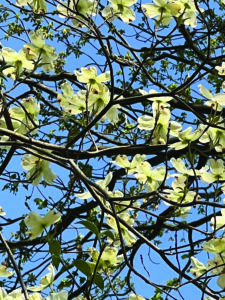
The Cornus florida dogwood tree has gentle horizontal branching and blooms with pure white, pink or red bracts in May. The true fertile flowers are contained in a central button that is surrounded by four large bracts that expand to 3-4 inches. (Photo by Ginny Rosenkranz)
Cornus florida is a wonderful deciduous native dogwood that loves to live with morning sun and afternoon shade.
These beautiful small trees live under the shade of larger trees, growing 15-30 feet tall and 15-25 feet wide.
In a landscape without trees, the flowering dogwood can be planted on the north or the east side of a home to allow the home to provide the afternoon shade.
They need rich, moist, acidic soils and a shallow inch of mulch around the base of the tree to maintain the cool moist soils for the shallow roots.
The tree has gentle horizontal branching and blooms with pure white, pink or red bracts in May.
The true fertile flowers are contained in a central button that is surrounded by four large bracts that expand to 3-4 inches.
Deep green oval leaves have veins that follow the oval pattern of the leaves.
In the autumn, the leaves turn attractive shades of red that blaze if the weather is warm during the day and cold during the night hours.
Autumn is also when the bright cherry red berries are held upright above the foliage, providing food for the native birds.
In the winter, the dark bark is displayed along with the horizontal branching, creating four seasons of beauty in the landscape.
Dogwoods are cold hardy from USDA zones 5-9 and are resistant to deer if they are in low numbers.
When dogwoods are drought stressed, they are more prone to dogwood anthracnose.
This disease produces tan spots that are bordered with dark purple on the lower leaves, and move upwards to the top of the plants.
Fortunately, there are a number of dogwoods that show good resistance to this fungal disease.
One is an old favorite, a native red flowering dogwood, Cornus florida “Cherokee Brave” with 4-inch flowers of large red bracts that fade to white in the center.
Another excellent new dogwood is Cornus florida “Appalachian Spring.” This beautiful dogwood has the bright white bracts surrounding the pale yellow fertile flowers in the center that become large bright red fruit in the fall.
The foliage is a soft medium green that in the autumn turns a reddish-purple. There is now a new disease that is bothering our native dogwoods, Powdery mildew. This disease grows during high daytime humidity and cool evening.
The Powdery mildew looks like a dusting of sugar on the tops of the leaves, but as the fungal colonies continues to feed on the foliage the green colors fade to yellow.
The Powdery mildew causes the young leaves to be stunted and curled, and often show a fall burgundy coloration.
New cultivars of Cornus florida that show excellent resistance to Powdery mildew include C. “Appalachian Joy,” C. “Jean’s Appalachian Snow,” C. Karen’s Appalachian Blush“ and C. “Kay’s Appalachian Mist.”
The colorful bracts on C. “Appalachian Joy” and C. “Jean’s Appalachian Snow” are pure white, while the bracts on C. “Karen’s Appalachian Blush” and C. “Kay’s Appalachian Mist” have reddish-pink blush on the bracts.
Our flowering dogwood is one of the spring’s most beautiful flowering trees in our landscapes..
(Editor’s Note: Ginny Rosenkranz is a commercial horticulture specialist with the University of Maryland Extension.)



